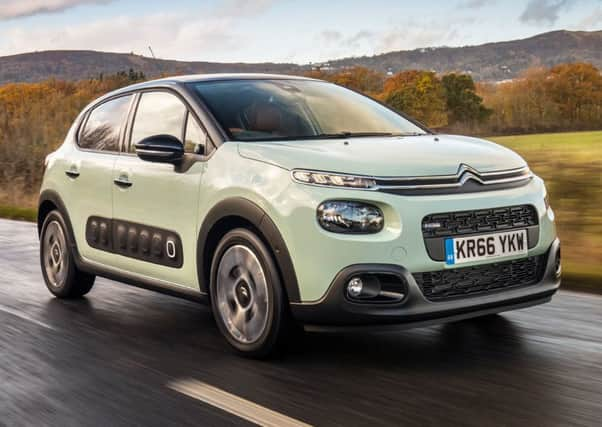Review: Smile! You're on a Citroën C3 supermini camera


C3 pioneers a forward-facing camera which can take single shots or video film for social sharing or proof of reckless driving. If an emergency incident is anticipated by the vehicle, the video switches on and can run for 90 seconds, of which 60 seconds follows the impact.
As it happened, during the car’s UK media debut in Worcestershire a hapless pick-up reversed into a C3 – all caught on film and causing minor trim damage seen on the car here. And yes, if the camera actually incriminates the C3 driver its record can be deleted. As if you would…
Advertisement
Hide AdAdvertisement
Hide AdAnother innovation is the light-coloured lining for the door pockets, which makes dark objects easier to find.
The C3 is the third version of the jaunty five-door, five-seater hatchback. It has been a good seller, with 3.6 million knocked out since 2002, of which 200,000 have come to Britain.
It’s a major revision rather than all-new and brings suspension which, praise them, has been retuned for comfort rather than racing. The roof is lower, the seats wider, the rear area roomier though this is still not a car for large people in the back. Parents and kiddies fit the size. It is on the seven-car shortlist for European car of the year.
There are three petrol engines, all 1.2 three-cylinder, with power outputs of 68, 82 and 110 horse power – the latter turbocharged. A pair of 1.6 litre turbo diesels with 75 and 100 horse power complete the offering. These are metric, or ps, ratings. Divide by 1.014 to get bhp and some fractions, viz 110ps becomes 108.5bhp. Gearboxes are manual five speed, with an electrically managed automatic 110hp model available shortly after the cars reach showrooms this month.
The models are Touch, Feel and Flair. Prices open at £10,995 for the 68hp Touch – also available with the 82hp engine at £11,695 and the 75hp diesel at a heady £13,295. The prices include 15 inch steel wheels (no spare), and a fair suite of safety systems, such as lane departure warning, speed sign recognition, tyre pressure monitor and DAB audio with Bluetooth phone connection. Air conditioning will cost you £600 and you can’t have the Airbumps – a divisive marketing move to push you to the Feel, the core model.
The Feel is the only one with all the engine options and is the one you should aim for. It costs from £13,045 for the 68hp petrol to £16,045 for the 100hp diesel. The jump in prices brings alloy 16 inch wheels with a slim spare, climate control, power mirrors, black roof and other cosmetics, powered windows, a seven-inch touchscreen with connectivity and the option of the Airbump door protection for £290 with cornering fog lamps thrown in for some reason. Note that without the Airbump the C3 flanks are left with the scalloped channel in which it sits. This is the de facto situation with the Touch model.
Flair models get the Airbumps as standard and the on-board camera – available for £380 on the Feel models. Flair’s engine choices are the 82, 110 and 100, from £14,795 to £15,995 to £17,095. Added kit includes automatic lights and wipers, leather wheel rim and gearknob, rear parking sensors and camera and bespoke cosmetic touches.
We tried the Flair with the 110hp petrol and 100hp diesel on pleasant up and down routes in the Malvern hills at tourist speeds. The petrol car recorded 40mpg, the diesel 51mpg. A flatter faster route in the 82hp petrol Feel showed 45mpg.
Advertisement
Hide AdAdvertisement
Hide AdRide comfort was as good as promised. The 110hp petrol engine had a jingle-jangle tickover, audible outside. The 82hp Feel was sweeter and if you don’t need the punchy flexibility of the bigger engines would be a good compromise (from £13,745).
None of the versions is fitted with roof grab handles, which you’ll miss if you are used to them. The door pulls are faux old-style cabin trunk flat straps and not at all ergonomic compared with a contoured handle. However, they look smart.
There is some token dimpling on the door panel to break up the dark expanse. Sadly – if these things matter to you – almost all the interior plastics have hard and cheap looking finishes. Those on the fascia are relieved by a lateral decorative band which contains cute oblong air vents. Depending on trim, this detail can be finished in red.
Flair and Feel models can have a no-cost option for red or white finish to the door mirrors and roof. It’s an effective colour scheme in a car which aims to be young and fun.
Verdict: Looks the part for its target customers. Nice ride comfort. On-board camera will appeal. Airbumps should be available on all versions.